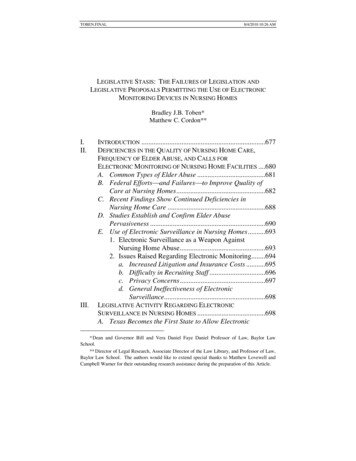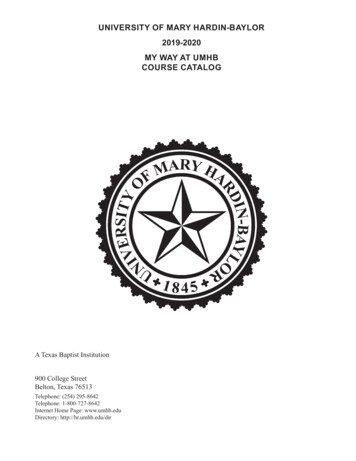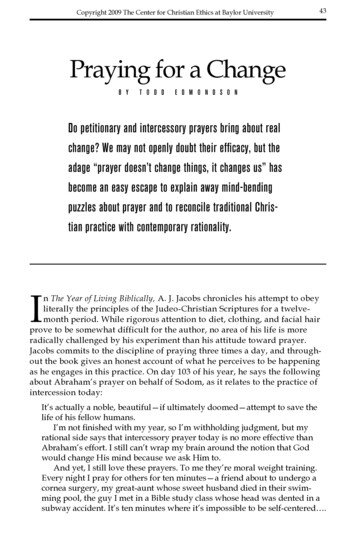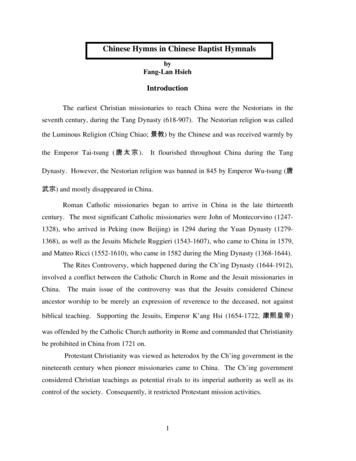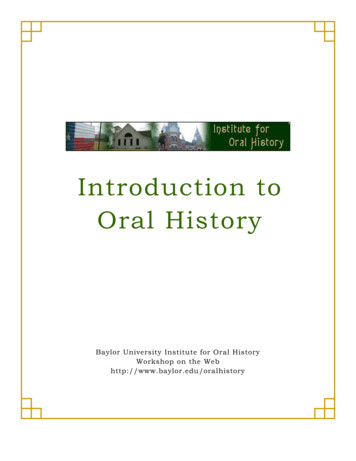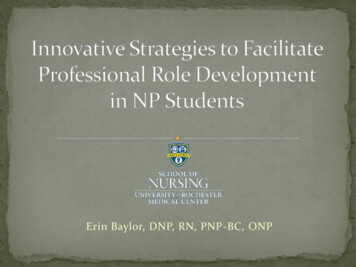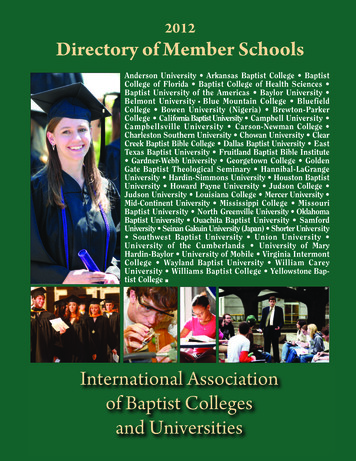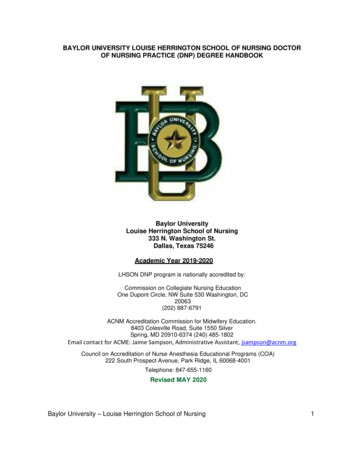
Transcription
BAYLOR UNIVERSITY LOUISE HERRINGTON SCHOOL OF NURSING DOCTOROF NURSING PRACTICE (DNP) DEGREE HANDBOOKBaylor UniversityLouise Herrington School of Nursing333 N. Washington St.Dallas, Texas 75246Academic Year 2019-2020LHSON DNP program is nationally accredited by:Commission on Collegiate Nursing EducationOne Dupont Circle, NW Suite 530 Washington, DC20063(202) 887-6791ACNM Accreditation Commission for Midwifery Education.8403 Colesville Road, Suite 1550 SilverSpring, MD 20910-6374 (240) 485-1802Email contact for ACME: Jaime Sampson, Administrative Assistant, jsampson@acnm.orgCouncil on Accreditation of Nurse Anesthesia Educational Programs (COA)222 South Prospect Avenue, Park Ridge, IL 60068-4001Telephone: 847-655-1160Revised MAY 2020Baylor University – Louise Herrington School of Nursing1
Table of ContentsIntroduction . 3Philosophy, Mission, History .3-6DNP Program Outcomes .7Academic Policies 8-15Course of Study. 8Transfer Credit .9Faculty Office Hours.9Registration and Advisement.9Grades and program progression.9-11Grievance (Student) Process . 11Academic Integrity 12Honor Code. .12Student Professional Conduct . .13Classroom and Clinical Etiquette. 13-14General Information, Policies & Procedures . 15-21Time Limitation . 15Licensure. 15Textbooks and Supplies . 15Pinning . 15Transcripts: Procedure for Obtaining. 15Badges. 16Name Changes . 16Address Changes. 16Cafeteria Information. 17Criminal Background Check and Drug Testing.17Parking Facilities . 18Security . 19University Correspondence. 19Health Services for Students. 19Counseling Services. 19Athletic Events . 20Recreational Activities. 20Insurance .20Student Health Insurance 20Judicial Administration 20-21Notary Public Service . 21Hazardous Weather. 21SIGMA. 21Immunizations and CPR . 21Title IX .21Student with Disabilities .22Library Services 23-24The DNP Project .25-28The DNP Portfolio .29US Army Graduate Program in Anesthesia Nursing (USAGPAN) 30Appendix A & B: Degree Plans . .31- 34Appendix C: Course Descriptions .35-43Appendix D: DNP Project Committee Form . . 44Appendix E: DNP Project Proposal Approval Form .45Appendix F: Completed DNP Project Attestation Form .46Appendix G: Request for Leave of Absence .47Appendix H: Academic Professionals and Support Staff 48Appendix I: USAGPAN Course Descriptions . . 49-53Appendix J: USAGPAN Academic Professionals and Support Staff .54Baylor University – Louise Herrington School of Nursing2
IntroductionThe Louise Herrington School of Nursing (LHSON) Doctor of Nursing Practice (DNP) degreeis a clinical doctoral program designed in response to professional mandates to moveadvanced nursing practice education to the doctoral level and to meet the societal need forimproved healthcare through the education of nurse practitioners (NPs) and midwives.The DNP program is congruent with the overall mission and strategic plan for BaylorUniversity as described in Pro Futuris, as well as the mission and philosophy for the LHSON.The program is of particular value to the LHSON because it prepares providers to care forvulnerable populations such as women and families in the United States and globally,reflects an approach to life as servant leader and professional nursing as a calling. A nursepractitioner or midwife prepared at the DNP level can promote and improve the quality ofhealthcare for individuals, populations and communities in the United States and across theglobe.PhilosophyThe faculty of Baylor University Louise Herrington School of Nursing (LHSON) believes inthe philosophy, the Christian mission, and the goals of Baylor University and, in harmonywith these, provides an environment in which the nursing student may grow in professionalcompetence and Christian spirit. The faculty believes nursing is a service to humanity and ismotivated by love for God and society. A commitment to this belief provides a foundation forteaching and learning in the LHSON.The faculty believes the aim of undergraduate and graduate education in nursing is toprovide an opportunity for personal and professional development. Professional educationincludes a study of the arts, sciences and humanities and is best achieved in a Christiansetting beginning at the Baccalaureate level. The faculty believes that baccalaureateeducation in nursing is the basis for professional practice as a nurse generalist and shouldbe equally accessible to generic students and to other students who have previous formaleducational experience in nursing. The nurse generalist has the knowledge, skills, andcompetencies necessary for assuming the responsibility of entry-level professional nursingpositions and for graduate study in nursing.The faculty believes specialization occurs at the level of graduate education in therefinement of existing skills, expansion of knowledge, and development of competencies in aspecific area of nursing practice.The faculty believes individuals learn in a variety of ways. Learning is a life-long processbuilt upon previous knowledge and experience. Learning occurs in a variety of situations andsettings and should become self-directed over time. Knowledge acquisition, critical inquiry,reflection and decision-making prepare learners to respond to issues that confront them asprofessionals.The faculty believes effective teaching employs a variety of strategies to fosterindependence, critical thinking and self-discovery. The teacher as a facilitator strives to beinnovative and flexible in planning, implementing, and evaluating educational experiencesconsistent with curriculum goals and objectives. The teacher as scholar participates inendeavors to acquire, create, and use new knowledge. As members of the academiccommunity, the faculty recognizes that its professional role includes formal teaching,scholarly pursuits and community service.Baylor University – Louise Herrington School of Nursing3
The faculty believes the individual, in constant interaction with the changing environment,responds as a unified whole to life situations. In addition, the individual impacts theenvironment and his/her own welfare through a personal relationship with the Creator. As anintegral part of a family, group or community the individual affects, and is affected by bothculture and society.The faculty believes health is a basic human condition which is uniquely perceived byindividuals and groups. Health is a dynamic state of human functioning wherein clients existwith varying degrees of wellness and illness. The higher the level of human need fulfillment,the more optimal the state of wellness for the client. Individuals have the right to pursue thatlevel of health perceived by them to be optimal, taking into account their social and culturaldefinitions of health. The level of health individuals can attain is influenced by the levels ofhealth of families and communities of which they are a part and with whom they coexist.The faculty believes professional nursing is the caring for individuals, families, groups,communities and society through the diagnosis and treatment of the responses to actual orpotential threats to health and through facilitating human need fulfillment. Professionalnursing is a practice discipline which has evolved from a rich, unique heritage. Itencompasses the arts, sciences, ethics, and politics. Nursing has a dynamic body ofknowledge based on nursing research and on the application of theories and concepts fromthe physical and behavioral sciences and the humanities. Professional nursing utilizes thenursing process in a caring, interactive manner to promote optimal wellness. Through avariety of roles, professional nursing contributes to the improvement of health care servicesto society.MissionOur mission at the Baylor University Louise Herrington School of Nursing is to preparebaccalaureate and graduate level nurses, within a Christian community, for professionalpractice, healthcare leadership and worldwide service.History of the School of NursingBaylor University, chartered by the Republic of Texas in 1845, was established by the UnionBaptist Association under the leadership of Judge R.E.B. Baylor, Rev. James Hickins, andRev. William Milton Tyron. Originally located in Independence, Texas, the university wasmoved to Waco, Texas, in 1886 and merged with Waco University, another Baptist School.The mission of Baylor University is to educate men and women for worldwide leadership andservice by integrating academic excellence and Christian commitment within a caringcommunity. The present university system includes the College of Arts and Sciences andthe Schools of Business, Education Law, Engineering & Computer Science, Institutes &Special Studies, Music, Nursing, Seminary and the Graduate School. Enrollment stands atapproximately 15,000 students.The School of Nursing was established in 1909 as a diploma program of the Texas BaptistMemorial Sanitarium, the forerunner of the present Baylor University Medical Center. In1950 the School became one of the six degree-granting schools within Baylor University.Graduating its first collegiate class in 1954, the School is one of the oldest baccalaureateprograms in the United States.Baylor University – Louise Herrington School of Nursing4
A number of nurse educators have provided outstanding leadership and have contributedsignificantly to the history of the School of Nursing. Helen Holliday Lehmann served asDirector when the School was a diploma program. She held this position from 1912 until1923 and again from 1930 until 1943. Under her administration, the program obtained a"Class A" rating and became one of two schools to meet all of the requirements of the NewYork Board of Nurse Examiners at that time. In 1943 Mrs. Lehmann was succeeded by ZoraFiedler who held the position of director until 1951. It was largely through her efforts that thebaccalaureate program was developed. Though the newly developed program wasestablished on the Waco campus, Baylor University Medical Center in Dallas was utilized asa clinical teaching facility in addition to clinical facilities in Waco.In 1954 the first class completed the new program and its members were granted theBachelor of Science in Nursing from Baylor University. Further refinement of the programcontinued as nursing courses were taught on both the Waco and Dallas campuses.Anne Taylor was appointed Dean in 1961. By this time, the School of Nursing, includingadministration, was based in Dallas on the Medical Center campus. During Miss Taylor'stenure, plans for Wilma Bass Residence Hall, which included classrooms and offices for theSchool of Nursing, were developed. In 1965 the School moved into the new facility, thesame year in which Dr. Geddes McLaughlin succeeded Miss Taylor as dean. Under DeanMcLaughlin's leadership, the School experienced significant increases in the number ofstudents and faculty. The Harry Bass Memorial Education Center was built to provideoffices and classroom facilities for the School of Nursing in 1977.Succeeding Dr. McLaughlin upon her retirement was Dr. Opal Hipps. Under the direction ofDean Hipps, Baylor University School of Nursing began admitting students in January aswell as September. The library facilities were separated from the College of Dentistry and aLearning Resources Center was established in Wilma Bass Hall. Lines of administrativeauthority were clarified in that the dean reported directly to the University administrators inWaco. A BSN completion program was begun for RN's. "Fall 2011 Facts" prepared by theOffice of Institutional Research and Testing, Baylor UniversityDr. Phyllis Karns was appointed dean in 1987. Under her direction the Learning ResourcesCenter was expanded and moved to the Harry Bass Education Building. The graduateprogram in Patient Care Management (later Advanced Nursing Leadership) admitted the firststudent in the Fall of 1990. The graduate program received initial accreditation from theNLN in the Fall of 1994. In Fall, 1998, the Family Nurse Practitioner track was added,followed by the addition of the Neonatal Nurse Practitioner track in the Fall of 2000. A jointBSN-MSN program was added in the Spring of 2001 to replace the previous RN completionprogram.A major facility expansion and renovation was completed in August 1999, nearly doublingthe size of the facility. Full national accreditation of the baccalaureate and graduateprograms was granted by CCNE from 1999 through June 30, 2010. In the Fall of 2000, theschool was endowed by Mrs. Louise Herrington Ornelas and was named the LouiseHerrington School of Nursing in her honor.Baylor University – Louise Herrington School of Nursing5
Dr. Judy Wright Lott was appointed as Dean in December 2002 and guided the transition ofthe Louise Herrington School of Nursing into the 21st century. Under her leadership, theschool grew in student numbers, programs, endowed funds, academic standing andpromotional activities. During her tenure the Barnabas Success Center, the Don and RuthBuchholz Simulation Laboratory, the Doctor of Nursing Practice (DNP) program and theAccelerated Second Degree (FastBacc) track were developed based on strategic plans forthe school. Guiding us through our Centennial anniversary and receiving full accreditationfrom CCNE for both undergraduate and graduate programs, Dr. Lott strengthened theChristian focus of the school and constantly promoted the new motto of the school: Learn,Lead, Serve. In 2012, Dr. Shelley F. Conroy joined the LHSON team as dean and professorof nursing. Dr. Conroy holds a Doctor of Education degree in curriculum and instruction fromthe University of Central Florida, a Master of Science degree in maternal-infant nursing fromVirginia Commonwealth University’s Medical College of Virginia and a Bachelor of Sciencein Nursing degree from Virginia Commonwealth University. Dr. Conroy’s extensivebackground as a tenured professor and dean at previous universities and her significantbackground in research, grants and sponsored projects will equip her to skillfully guide thenursing school during this important time of progress and transition in the area of healthprofessions education. With more than 30 years of experience in higher education, healthcare administration, and nursing and health care research, she believes the Lord has usedher life story and experiences to prepare her for this leadership position at Baylor.Baylor University – Louise Herrington School of Nursing6
DNP Graduate Program OutcomesCompetencies expected of a DNP graduate from the LHSON are congruent with the eightThe Essentials for Doctoral Education for Advanced Practice published by the AmericanAssociation of Colleges of Nursing (2006). The curriculum is designed to enable thegraduate to attain these outcomes:1. Synthesize scientific evidence and methods to design, direct, and evaluate strategies topromote effective patient-centered care.Essential I: Scientific Underpinnings for PracticeEssential III: Clinical Scholarship and Analytical Methods for Evidence-Based Practice2. Incorporate leadership skills and interprofessional team building strategies to improvequality metrics within health care systems, organizations, and diverse practice settings.Essential II: Organizational and Systems Leadership for Quality Improvement andSystems Thinking3. Employ information systems and technology in the delivery of transformative health care.Essential IV: Information Systems/Technology and Patient Care Technology for theImprovement and Transformation of Health Care4. Advocate for evidence-based health policy to improve local, national, and/or globalpatient and health population outcomes.Essential V: Health Care Policy for Advocacy in Health Care5. Utilize effective interprofessional communication and collaborative skills to facilitateimprovement in population health.Essential VI: Interpro
The DNP program is congruent with the overall mission and strategic plan for Baylor University as described in Pro Futuris, as well as the mission and philosophy for the LHSON. The program is of particular value to the LHSON because it prepares providers to care for



